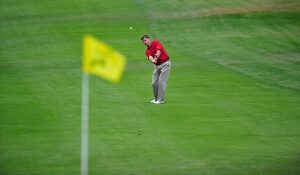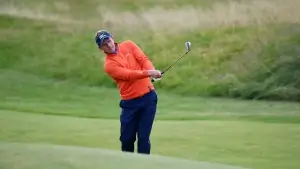There are A LOT of golf terms. Some – like an ace – are pretty intuitive. But bite, snowman, eagle? These terms can leave you scratching your head.
So today we’ve compiled a list of common golf vocabulary to help you learn the language. And if you’re a seasoned golfer take a look and see, how many golf terms do you really know?
Below, are the basic golf terms
Scoring
-
Par: The expected number of strokes an expert golfer should take to complete a hole.
-
Birdie: Completing a hole in one less stroke than par.
-
Bogey: Completing a hole in one more stroke than par.
-
Double Bogey: Completing a hole in two more strokes than par.
-
Eagle: Completing a hole in two fewer strokes than par.
-
Albatross: Completing a hole in three fewer strokes than par.
-
Stroke: A single forward swing of the club in an attempt to hit the ball.
-
Score: The total number of strokes taken to complete a round or hole.
Clubs
-
Driver: The longest club in the bag, used for tee shots.
-
Wood: A club with a large, rounded head made of wood or metal, typically used for long-distance shots.
-
Hybrid: A cross between a wood and an iron, designed for easier distance control.
-
Iron: A club with a smaller, more angled head made of metal, typically used for shorter shots.
-
Wedge: A specialized iron with a high loft, designed for chipping and pitching around the green.
-
Putter: A club with a flat face and no loft, used for rolling the ball on the green.
Course Layout
-
Fairway: The short grass that runs from the tee to the green.
-
Rough: The longer grass that surrounds the fairway and greens.
-
Green: The area of closely cropped grass where the hole is located.
-
Tee: The raised area from which players start each hole.
-
Hazard: A natural or man-made obstacle on the course, such as a lake, bunker, or tree.
Ball Movement
-
Slice: A shot that curves sharply to the right (for a right-handed golfer) due to an open clubface at impact.
-
Hook: A shot that curves sharply to the left (for a right-handed golfer) due to a closed clubface at impact.
-
Draw: A controlled shot that curves gently to the right (for a right-handed golfer).
-
Fade: A controlled shot that curves gently to the left (for a right-handed golfer).
-
Top: A shot that hits the top of the ball, resulting in a low, spinning trajectory.
-
Chunk: A shot that hits the ground too close behind the ball, resulting in a high, popping trajectory.
Other Terms
-
Fore: A warning shout yelled by golfers to alert others of a wayward ball.
-
Mulligan: A do-over shot, typically taken on the first tee or after a particularly bad shot.
-
Gimmick: An informal term for a rule or procedure that allows a golfer to improve their lie or take relief from an unfavorable position.
-
Handicap: A numerical measure of a golfer’s skill level, used to normalize scores for competitive play.
-
Golf cart: A motorized vehicle used to transport golfers around the course.
-
Green fee: The fee charged to play a round of golf at a course.
Equipment
-
Grip: The way the golfer holds the club in their hands.
-
Stance: The golfer’s posture and positioning over the ball.
-
Alignment: The golfer’s aim and direction of the intended shot.
-
Backswing: The upward motion of the clubhead away from the ball.
-
Downswing: The downward motion of the clubhead towards the ball.
-
Impact: The moment the clubhead strikes the ball.
-
Follow-through: The continuation of the swing after the ball has been struck.
-
Lag: The proper timing of the release of the hands in the swing.
-
Loft: The angle of the clubface, which determines the trajectory of the ball.
-
Lie: The position of the ball relative to the ground, whether uphill, downhill, or level.
Course Hazards
-
Bunker: A sand-filled area that is a difficult obstacle to escape from.
-
Water hazard: A lake, pond, or stream that can penalize a golfer with a lost ball.
-
Tree: A large obstacle that can block the path to the green or deflect a shot.
-
Out-of-bounds: An area beyond the boundaries of the course, resulting in a lost ball.
-
Lateral hazard: A hazard that runs parallel to the fairway, such as a ditch or a fence.
Rules and Etiquette
-
Ready golf: The practice of playing without waiting for the group in front to finish their hole.
-
Pace of play: The speed at which a group of golfers progresses around the course.
-
Etiquette: The polite and respectful behavior expected of golfers on the course.
-
Dress code: The appropriate attire for playing golf at a particular course.
-
Scorecard: The record of each golfer’s score on each hole.
Specialized Terms
-
Shank: A shot that hits the hosel of the club, resulting in a wild, unpredictable trajectory.
-
Skull: A shot that hits the ball above its equator, resulting in a low-line drive.
-
Flip: A shot that is hit with too much wrist action, causing the clubface to open at impact.
-
Push: A shot that starts straight but drifts to the right (for a right-handed golfer).
-
Pull: A shot that starts straight but drifts to the left (for a right-handed golfer).
-
Thin: A shot that hits the ball on the bottom edge of the clubface, resulting in a high, weak trajectory.
-
Fat: A shot that hits the ball too close in front, resulting in a low, powerful trajectory.
-
Yips: A nervous twitch or flinch that can affect a golfer’s putting stroke.
-
Gimmie: A conceded short putt, typically within a tap-in distance.
-
Wolf: A hole-in-one scored with a second or third shot after a missed tee shot.
Ball Marks
-
Pitch mark: A small indentation in the green caused by a wedge shot.
-
Scuff mark: A mark left on the green by dragging the club.
-
Spike mark: A mark left on the green by a golfer’s shoes.
-
Divot: A piece of turf torn up by a clubhead.
Greenside Terminology
-
Stimpmeter: A device used to measure the speed of the greens.
-
Fringe: The area surrounding the green that is slightly closer to the ground than the fairway.
-
Collar: The area surrounding the hole that is cut very short.
-
Backstop: A raised area behind the green that prevents balls from rolling away.
-
Slope: The inclination of the green, which can affect the speed and direction of the ball.
Golf Terminology related to wind:
-
Downwind: A shot played with the wind blowing in the direction of the target.
-
Upwind: A shot played with the wind blowing against the direction of the target.
-
Crosswind: A shot played with the wind blowing across the direction of the target.
-
Tailwind: A wind that blows behind the golfer, assisting the shot.
-
Headwind: A wind that blows in front of the golfer, making the shot more difficult.
Golf Terminology related to practice
-
Range: An area where golfers can practice their shots.
-
Driving range: An area where golfers can practice their tee shots.
-
Chipping area: An area where golfers can practice their chipping shots.
-
Putting green: A practice green where golfers can practice their putting.
-
Practice swing: A swing taken without hitting the ball to warm up or check the lie of the ball.
Additional Golf Terminology
-
Birdie juice: A celebratory drink taken after a birdie.
-
Bogey blues: The feeling of disappointment after making a bogey.
-
Eagle eye: The ability to spot a golf ball from a distance.
-
Happy Gilmore: A golfer who hits the ball with excessive force.
-
Sandbagging: Intentionally underachieving in practice to gain an advantage in competition.
If you have any terms you’d like to add to this list, please shoot us a message!



